Dispatches from Peace Corps Mongolia
by joey |
Hayley Crow, RN, came to Mongolia as a Peace Corps Volunteer in the summer of 2014. Her first visit to the hospital, though, was as a patient with appendicitis at the start of her two-month Peace Corps language and cultural training.
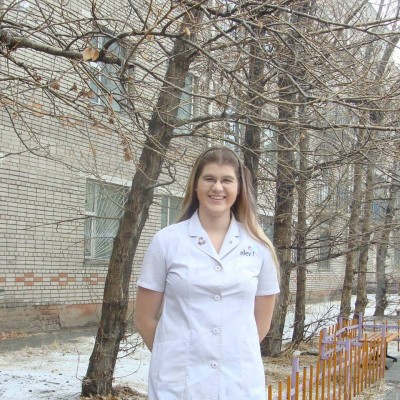
I AM UAA: Hayley Crow, B.S. Nursing Science '14, stands outside the hospital in Mongolia where she serves as a Peace Corps volunteer. (Photo courtesy of Hayley Crow)
It was the first of many surprises as a medical volunteer in Mongolia. Though a self-described "mediocre" three-sport athlete at Glennallen High School, she's become the star (also the tallest player) of her hospital's basketball and volleyball teams (additional surprise: Mongolian hospitals field sports teams for staff). She likewise didn't know she'd be mistaken for a Russian citizen so frequently. She didn't expect to adopt a pet rabbit with a chronic case of head tilt, so one eye is always staring at the ceiling (the rabbit's name, fittingly, is Halibut). And she certainly didn't expect to live in an 11th floor apartment in the heart of the capital city. While most Peace Corps volunteers leave city life behind and spend two years in remote communities, Hayley left behind tiny Glennallen-pop. 483-and experienced the reverse, getting placed in Ulaanbaatar-pop. 1.5 million.
With hot summers, frigid winters and numerous towns off the road system, the transition to Mongolia was unique for Hayley; seemingly familiar in many ways, but jarringly different in others. Unlike her city-mouse colleagues, she had already experienced isolated towns, the richness of subsistence culture and the vast stretches of nothing but wilderness here in Alaska. The big change was the trees. "No matter what I thought about our deformed little spruces back home, at least we had a lot of trees," she joked.
Big city living
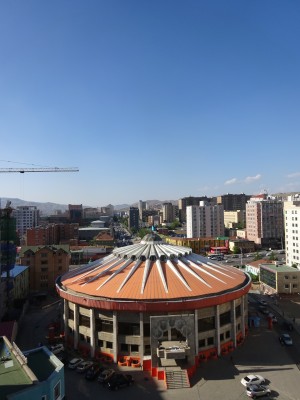
Hayley's building overlooks the Wrestling Palace, a landmark in Ulaanbaatar, where nearly half of Mongolia's population resides. (Photo by J. Besl)
Mongolian Peace Corps volunteers start their service with a crash course in the local language and lessons on the nation's health and education system. Each volunteer lives with a host family, so the learning experience is truly round-the-clock. At the end of the two-month training, volunteers attend a graduation ceremony-often dressed in local garb provided by their new Mongolian parents-and learn where they'll serve the next two years. When Hayley's location was announced, she wasn't the only one surprised.
"I was shocked when they called UB for me," Hayley admits, referring to the capital city of Ulaanbaatar. Of the 80 volunteers sworn in, she was probably best prepared to spend two years in the hoodoo, or countryside (yes, that's also the name of a Fairbanks brewery... the connections between Alaska and Mongolia never stop). Instead, she ended up in an apartment behind one of the capitol's major landmarks-the Wrestling Palace-with the sounds of constant traffic rippling through her windows. While other volunteers need to take a 48-hour bus ride through the desert just to see a dentist, Hayley lives a mere 2 kilometers from the Times Square of Mongolia, Sukhbaatar Square. "Everyone in my group was stunned I came here," she laughed,
The path to Peace Corps
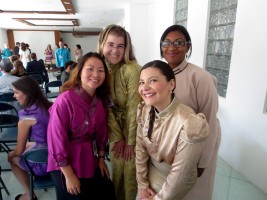
Hayley, second from left, and a few other Peace Corps volunteers dressed in traditional deels at the end of their training. (Photo courtesy of Hayley Crow)
But how did she get to Mongolia in the first place?
In a way, UAA's nursing program led Hayley to the Peace Corps. "Part of the good thing about nursing school was working a lot of different places," Hayley noted. At UAA, she completed rotations at three hospitals in Anchorage, as well as at Lake Otis Elementary School and even the local prison. As graduation neared, Hayley had an idea for the career options ahead of her and knew she wanted to keep exploring.
"I was looking into different things and Peace Corps looked like a really good idea," she said. While some applicants wait years before receiving an invitation, Hayley's medical background quickly landed her an interview. She was among the last class of volunteers under Peace Corps' old system, where applicants received a letter announcing their destination (as of 2014, applicants can now select a specific country and even a specific job).
Although Hayley didn't select Mongolia, she certainly had a say. "I told them I wanted to go somewhere cold... I figured I'd melt if I went somewhere too hot," she said. According to her interviewer, half the Alaska applicants request the cold, while half never want to be cold again. Hayley got her wish; Ulaanbaatar is famously known as the world's coldest capital city (overnight temperatures this week have hovered around -35° F).
More challenges, more surprises
Each morning, Hayley walks 30 minutes along the capitol's major east-west thoroughfare (yes, even in winter) to get to her hospital in the Bayanzürkh District, one of the city's poorest areas. Located on the east side of the city-just a short trolley ride from the main square downtown-it's primarily a neighborhood for newly arrived migrants. "A lot of times they come in with just the clothes on their back and their ger in the back of the car," Hayley said of the area, referring to the yurt-like homes-called gers-inhabited by nomadic families.
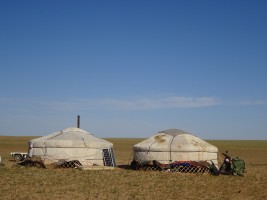
Gers, commonly spotted in the countryside, are also a regular sight in densely packed city neighborhoods as more families flock to Ulaanbaatar. (Photo by J. Besl)
Rural Mongolians in the hoodoo are typically herding families, raising goats and sheep, selling milk, cheese and wool, living off the land and moving their gers several times a year to greener pastures. However, urbanization has led thousands of Mongolians into Ulaanbaatar to scrape together a life in the city. The low-income population in Bayanzürkh has left the district hospital, in Hayley's words, on a "shoestring budget."
Which creates a significant string of problems for patients, and more surprises for Hayley. In Alaska, hospitals assign about five patients per nurse; in Mongolia, that ratio is more likely 30:1. Some problems are startlingly simple from an American perspective-small commodities like soap and toilet paper are occasionally unavailable-while other issues have graver implications. For example, there's no portable AED, the life-saving paddles that deliver electric charges to the heart.
In the USA, you'll find portable AEDs everywhere from shopping malls to summer camps but, at Bayanzürkh District Hospital, patients must be brought to the wall-mounted AED. Oh, and the four-floor building has no elevator. "If someone's in a wheelchair we literally have to carry the wheelchair up the floors," Hayley noted. She's currently working on funding for both a portable AED and an electric stair climber to navigate the hospitals tricky triangle-shaped central staircase.
The grant writing is certainly a side of nursing she wouldn't have experienced here in Alaska. Likewise the external relations. Though she sees patients, Hayley is primarily a Western liaison and often works with Red Cross, Rotary Club and human traffic awareness agencies in Ulaanbaatar. "It's a good learning experience," she says.
Long days, short weeks
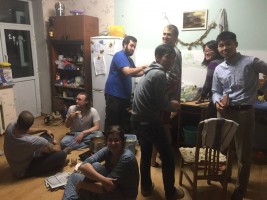
Hayley, seated in the center, with several friends she's made during her two years in the Peace Corps. (Photo courtesy of Hayley Crow)
That learning experience has benefited her career, but also expanded her outlook. "Just coming over here and seeing a new culture, you don't realize how good you have it in America," she said. In Mongolia, many generations live under the same roof, often in the same room. During training, Hayley would travel to a well with her host sister to retrieve water, which then needed boiling and filtering. Even her big-city apartment loses hot water and electricity each summer during construction season.
Like all Peace Corps volunteers, Hayley's experience has been challenging, remarkable and irreplaceable. She takes the train to her host family's house for Mongolian holidays and invites others to her home for American holidays. While she's learned from her colleagues, she's shared just as much, like teaching her host family how to swim in the local river.
Her experience is similar to that of the 220,000 volunteers who've returned since Peace Corps launched in 1951; some days are full of frustrations, while the next is all fascinations.
And somehow, inexplicably, the long days combine into short weeks; after two years in Mongolia, Hayley will return this summer to start her nursing career in Alaska.
Hayley isn't the only 2014 grad serving in the Peace Corps. Read an update from Alejandro Buitrago, B.A. '14, on her time in Burkino Faso in the most recent Alumni Spirit magazine.
In the same issue, you can learn more about the copious connections linking Mongolia and Alaska together.
Hear more musings from UAA's returned Peace Corps volunteers in Green & Gold News.
 "Dispatches from Peace Corps Mongolia" is licensed under a Creative Commons Attribution-NonCommercial 4.0 International License.
"Dispatches from Peace Corps Mongolia" is licensed under a Creative Commons Attribution-NonCommercial 4.0 International License.









